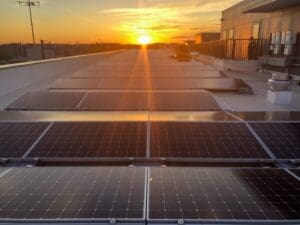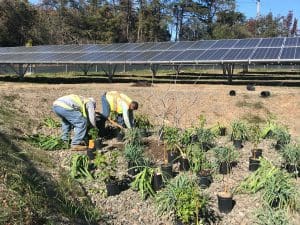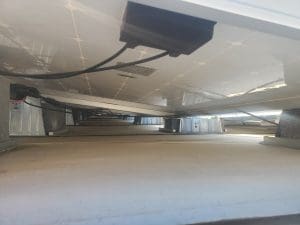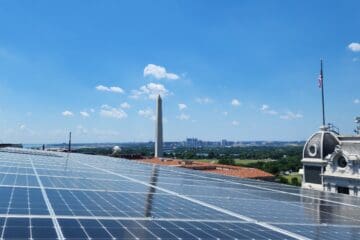A reinstatement of the 30% ITC, incentives for domestic renewable energy manufacturing, and big boosts for community solar
Yes- we are jumping on the band wagon along with every other clean energy, political and economic blog in the U.S. and writing about the Inflation Reduction Act. But the reason isn’t because we are hoping to have a better angle or new analysis, it’s because the passage of this bill is a really big deal. With such a divided [and nearly defunct] Congress, the Democrats united their votes in both Houses and pushed a large piece of legislation through that addressed both healthcare costs and clean energy & climate goals. To be clear, although the bill accomplishes a lot it did not go as far as to incorporate the Civilian Climate Corps Biden ran on and included in Executive Order 14008. Nor does it allow for a phase out of those dirty fossil fuel projects (the oil companies really need to read the memo that it’s not the 1960s anymore). But it does accomplish some much-needed provisions to move the U.S. forward and join the rest of the world in a bolder renewable energy future.
The first, and most obvious, clean energy win is the extension of the ITC, amping it back up to 30%. For years, the ITC has been on an unstable yo-yo ride as part of a bargaining chip, added to various bills, taken out, put back in then finally became a part of a 2015 bill (and subsequent 2020 spending package) that put its projection at 30% until the end of 2021 with a step down to 26% in 2022, another step down that was scheduled for next year (2023) was a second step down to 22% before a final step down to *only 10%* in 2024 and beyond. This was devastating to the industry, as the federal solar tax credit had been a great incentive for both businesses and residences to go solar. But the Inflation Reduction Act set the ITC back at 30% for the next decade with prevailing wage stipulations in place (LOVE this).
Photo credit: Pixabay
The Good
Here’s a further rundown of some of the renewable energy highlights from the bill:
- It allows for huge potential tax incentives for community solar. PV Magazine points out that the legislation adds a 10% tax incentive for domestic generation, 10% if sited in a former fossil fuel community, and an added 10% for community solar to low-income households would add to an additional 30% tax incentive *on top* of the 30% ITC, making LI community solar in a renewable-switched community tax incentive gold.
- It provides billions towards renewable + storage grants in rural areas, creating more opportunity to green the grid in all parts of the country, not just high density areas.
- It allocates $3 billion for the US Postal Service to electrify its fleet, $1 billion for cleaner trucks, buses and other large vehicles to clean transport. It also provides additional credits for EVs, like a $4k incentive for used EVs and a $7,500 credit for new ones.
- A reinstatement of the Superfund Tax so industry (not taxpayers) pay for the pollution industry creates. Whose idea was it to let that expire?
- $20 billion towards assisting farmers across the country to implement sustainable farming practices
- $50 million will go towards old-growth forest protection (not nearly enough) and over $2 billion will go towards coastal resilience grants.
Read Also:
Photo credit: Pixabay
We’re not done yet.
It also provides $60B for manufacturing solar panels here in the U.S. Some fun facts & background on this: the Solar Energy Manufacturing for America Act was introduced last year by Senator Jon Ossoff, the senator from Georgia who just narrowly won his seat (50.6-49.4%) in the runoff election of January 2021. Part of Ossoff’s platform was to drastically reduce fossil fuel consumption and switch to a clean economy while creating new greener jobs in the process. This bill was incorporated into the Inflation Reduction Act in order to add an element of homegrown manufacturing jobs to create the technologies that will be used to transition us to the new green economy. The bill was co-sponsored by his Georgia colleague Rev. Warnock who also had a vision of moving away from dirty energy & embracing clean tech. Moral of the story- these were close races. Voting climate matters.
Photo credit: Rathaphon Nanthapreecha/Pexels
The Not-So-Good
- Tax credits for carbon capture & sequestration tech for dirty coal plants (we’d rather they just close). This will allow dirty air pollution to spew longer in coal plant communities.
- The other compromise is the stipulation of the government having to lease millions of acres of both on & offshore land to oil and gas companies. Sounds horrific, I know. The hope, though, is that the large oil companies (the only ones that have the resources to drill in the Gulf, for instance) will take a pass on buying much of this land proffered at the auctions. Last year, the government offered up 80 million acres in offshore auction but only 1.7 million acres were actually bought. The appetite for offshore Gulf drilling has subsided, due to increasing costs of drilling in deeper water, a more tricky proposition. Exxon, instead, has apparently set its sights on less-tapped oil fields in Suriname and Guyana. In other words, exploiting a less-developed country where drilling is cheaper and likely more abundant is the current business plan for the oil companies. Parasites tend to work in similar ways.
- I’m going to mention the old-growth forest protection funding of $50 million here too, to put a fine point on the fact that it is way underfunded. This SHOULD BE a climate priority.
In all, though, the bill is definitely a big step in the right direction, even with its down sides. It also had provisions for healthcare as well (although tepid) that will surely be built upon in the near future. Say it & it will happen. In the meantime, here’s some light reading of the full IRA of 2022 (H.R. 5376) all 730 pages & 295 amendments of it.






